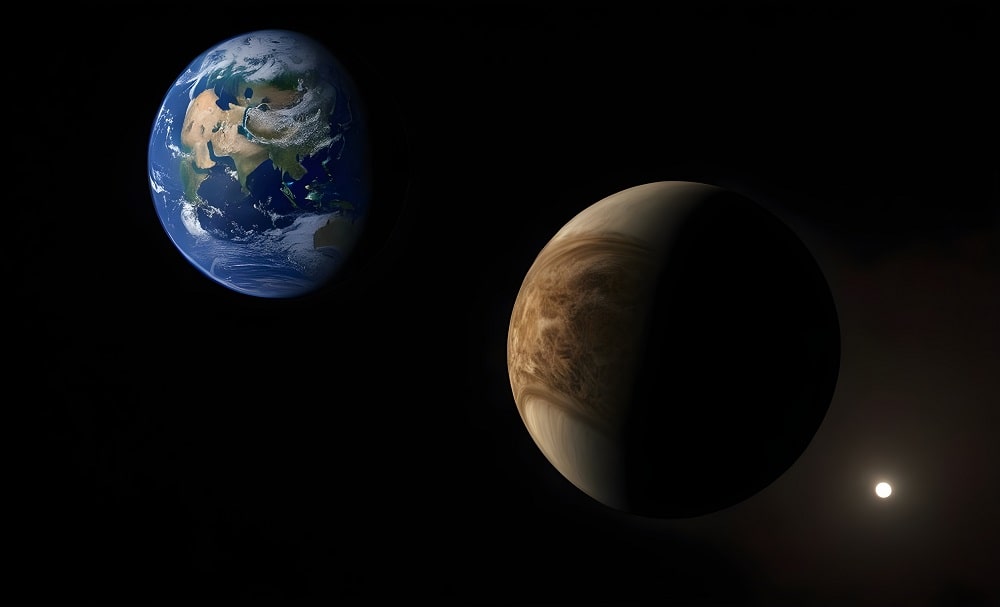Have you ever wondered why Earth and Venus, despite their similarities, are so dissimilar? Scientists theorize that these two planets were born as cosmic twins approximately five billion years ago. Initially, they shared similar characteristics in terms of mass, density, and composition. However, a cosmic event intervened, leading to their divergent paths. Around 4.5 billion years ago, a protoplanet known as Theia collided with Earth, resulting in the formation of our Moon and triggering rapid changes in Earth's rotation and tilt, leading to the development of strong magnetic fields. Similarly, Venus experienced a collision during that period, albeit smaller in scale compared to Earth's. This collision caused Venus to rotate more slowly and in the opposite direction to Earth, resulting in its weak magnetic field. Over time, Venus transformed into a scorching inferno, while Earth evolved into a lush green haven.
Giant Impact Hypothesis
The Giant Impact Hypothesis is a scientific theory that explains the formation of the Moon. According to this hypothesis, around 4.5 billion years ago, during the early stages of the solar system's formation, a Mars-sized protoplanet, often referred to as "Theia," collided with the young Earth. This collision was extremely powerful, ejecting a significant amount of material into space.
The debris resulting from this collision eventually formed a ring of molten rock and dust around Earth. Over time, this material began to coalesce due to gravitational forces, eventually forming the Moon. The Moon's composition and orbit are consistent with this theory, as it shares similarities with Earth's composition and orbits relatively close to our planet.
The Giant Impact Hypothesis is widely accepted within the scientific community as the most plausible explanation for the Moon's formation, although there are ongoing studies and debates to refine the details of this theory.
Gaining insights into Earth and Venus
Understanding Earth and Venus involves delving into their respective compositions, atmospheres, surface features, and overall environmental conditions. Despite being known as "twin planets" due to their similar size, mass, and proximity to the Sun, Earth and Venus present striking contrasts in terms of their atmospheres, surface conditions, and habitability.
Composition and Size
- Earth: Earth is composed primarily of iron, oxygen, silicon, magnesium, sulfur, nickel, calcium, and aluminum. It has a solid surface made up of various geological formations, including continents, oceans, and mountains. Earth's diameter is about 12,742 kilometers.
- Venus: Venus shares a similar size to Earth, with a diameter of about 12,104 kilometers. Its composition includes a thick atmosphere mainly composed of carbon dioxide, with traces of nitrogen and other gases. The surface of Venus is rocky and consists of plains, mountains, and volcanoes.
Atmospheres
- Earth: Earth's atmosphere is predominantly nitrogen (about 78%) and oxygen (about 21%), with trace amounts of other gases like argon, carbon dioxide, and water vapor. This composition supports life as we know it, maintaining a stable climate and protecting the surface from harmful solar radiation.
- Venus: Venus has a dense atmosphere composed mainly of carbon dioxide (about 96.5%), with small amounts of nitrogen and sulfur dioxide. The thick atmosphere creates a strong greenhouse effect, trapping heat and leading to extremely high surface temperatures, making Venus the hottest planet in the solar system.
Surface Conditions
- Earth: Earth's surface features diverse environments, including oceans, continents, deserts, forests, and polar regions. It supports a wide range of life forms, from microscopic bacteria to complex organisms like humans. Earth's surface temperatures vary widely depending on location and season.
- Venus: Venus's surface is inhospitable, with temperatures reaching up to 462°C (864°F), hotter than the surface of Mercury despite being farther from the Sun. The high temperatures are a result of the intense greenhouse effect caused by the thick atmosphere, which also produces crushing atmospheric pressure at the surface.
Geological Activity
- Earth: Earth is geologically active, with tectonic plate movement, volcanic eruptions, earthquakes, and other geological processes shaping its surface over millions of years. These processes contribute to the recycling of materials and the maintenance of a habitable environment.
- Venus: Venus also exhibits signs of geological activity, including volcanic eruptions and surface deformation, but at a slower pace compared to Earth. The lack of plate tectonics on Venus may contribute to its relatively uniform surface compared to Earth.
Habitability
- Earth: Earth is the only known planet to support life, with a rich diversity of organisms thriving in various ecosystems. Its moderate temperatures, liquid water, and protective atmosphere make it uniquely suited for life as we know it.
- Venus: Despite its similarities in size and proximity to Earth, Venus is uninhabitable due to its extreme surface conditions, including high temperatures, acidic clouds, and toxic atmospheric composition. However, some scientists speculate that Venus's upper atmosphere, where conditions are milder, could potentially harbor microbial life.













0 comments:
Post a Comment